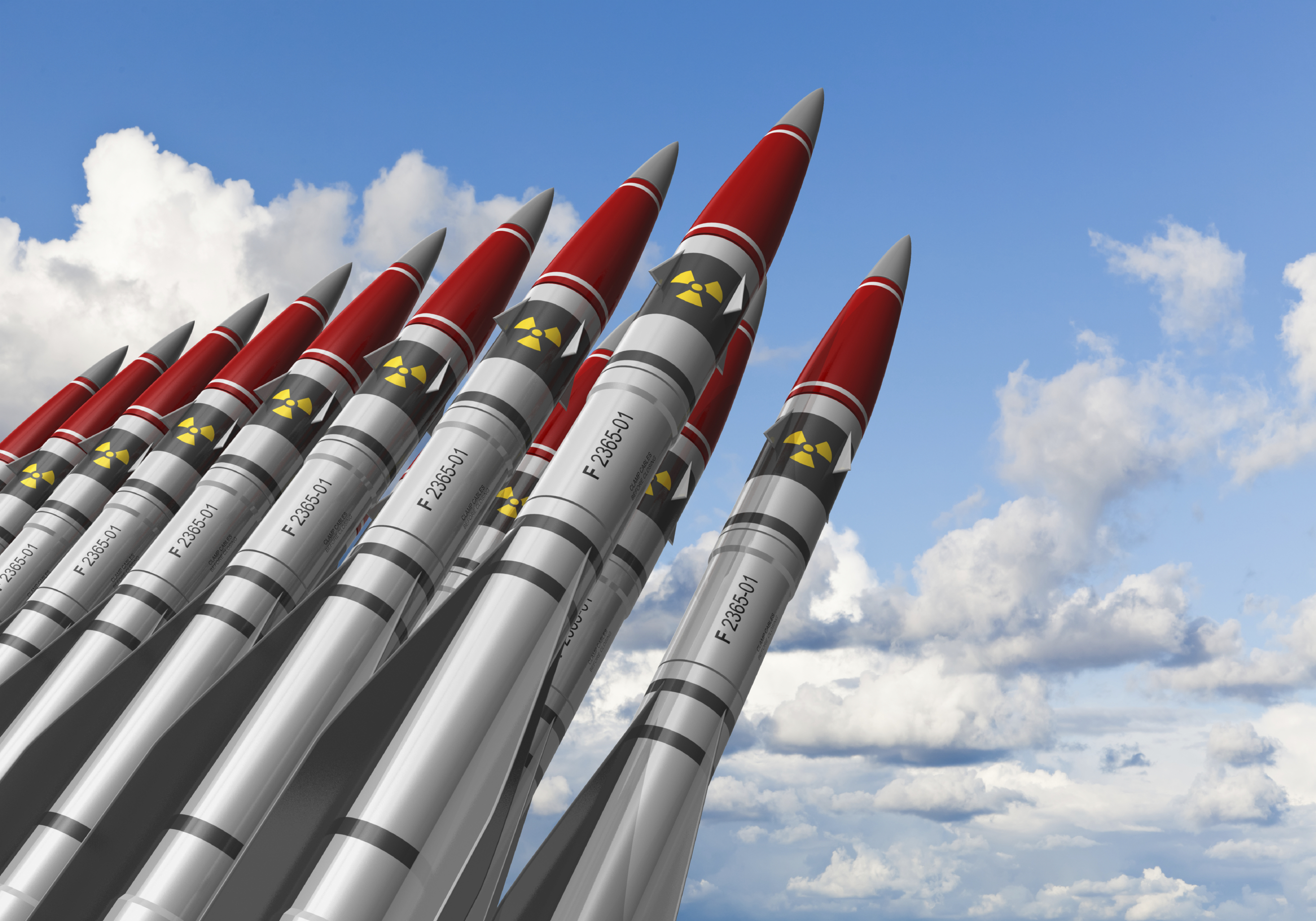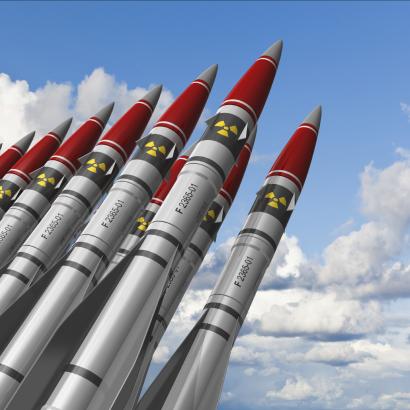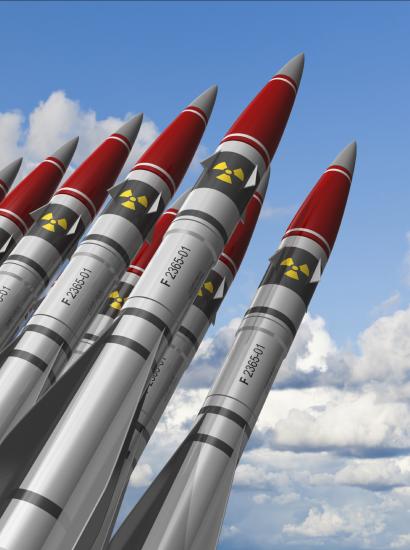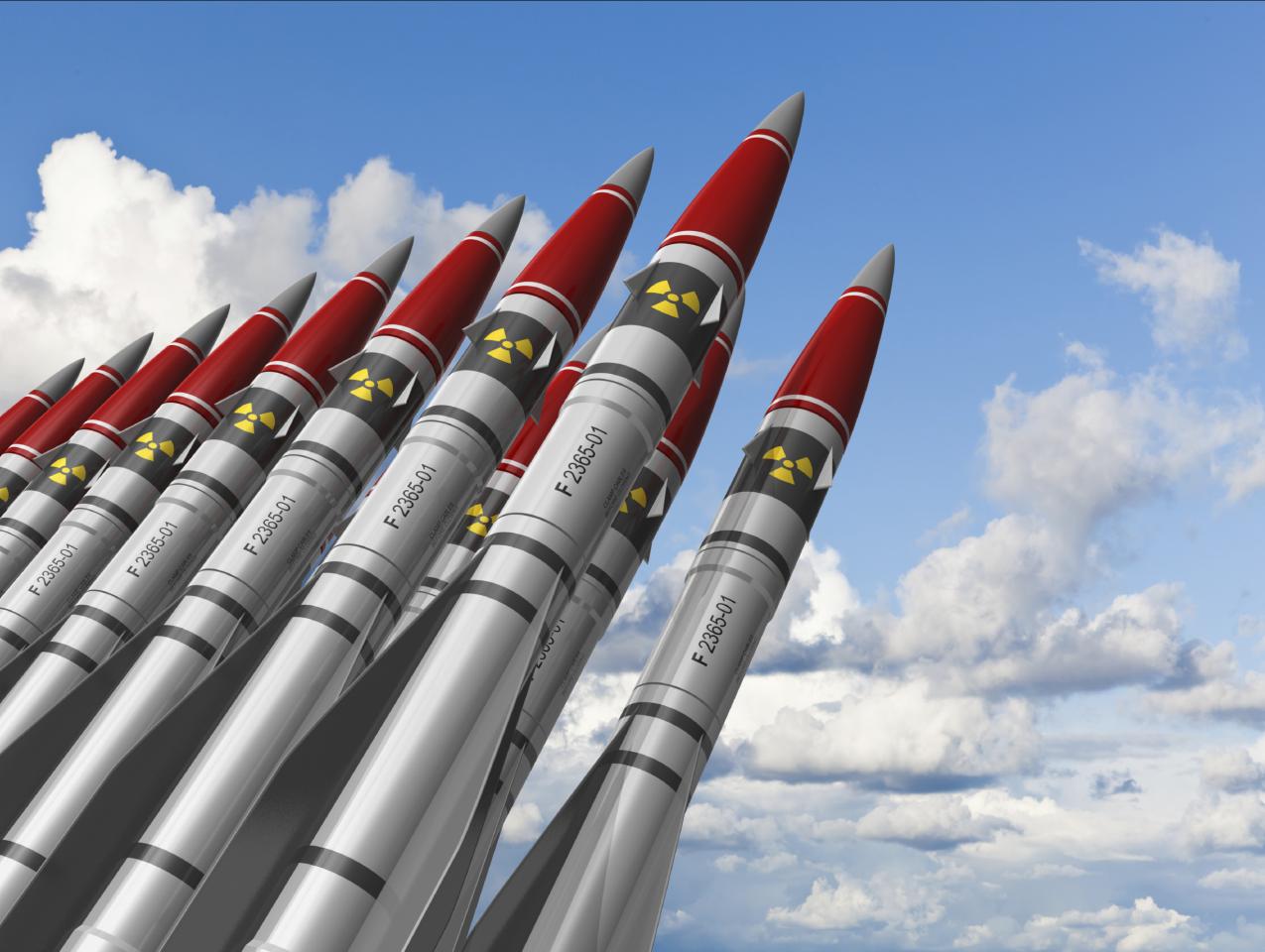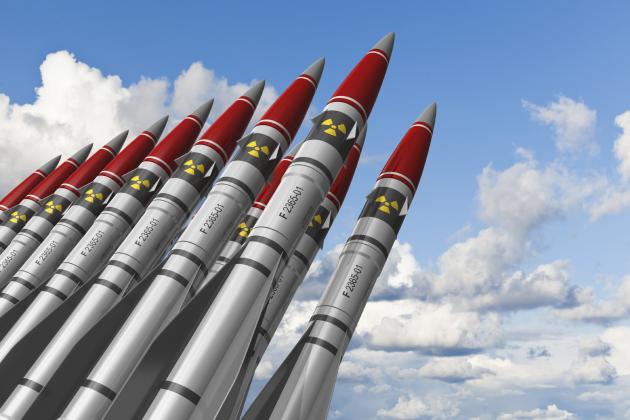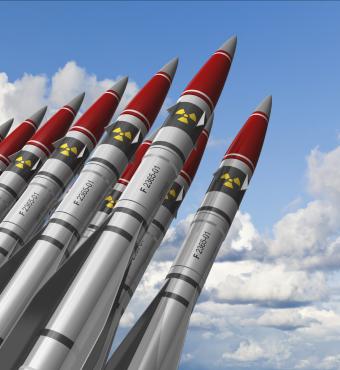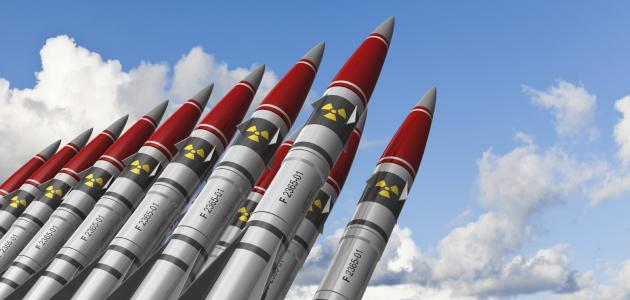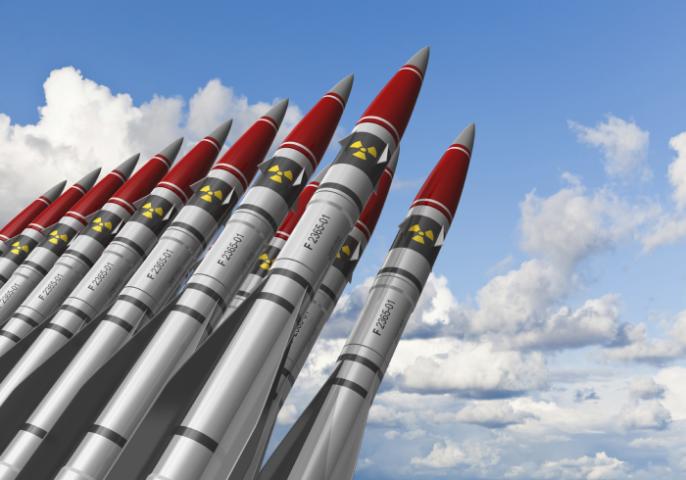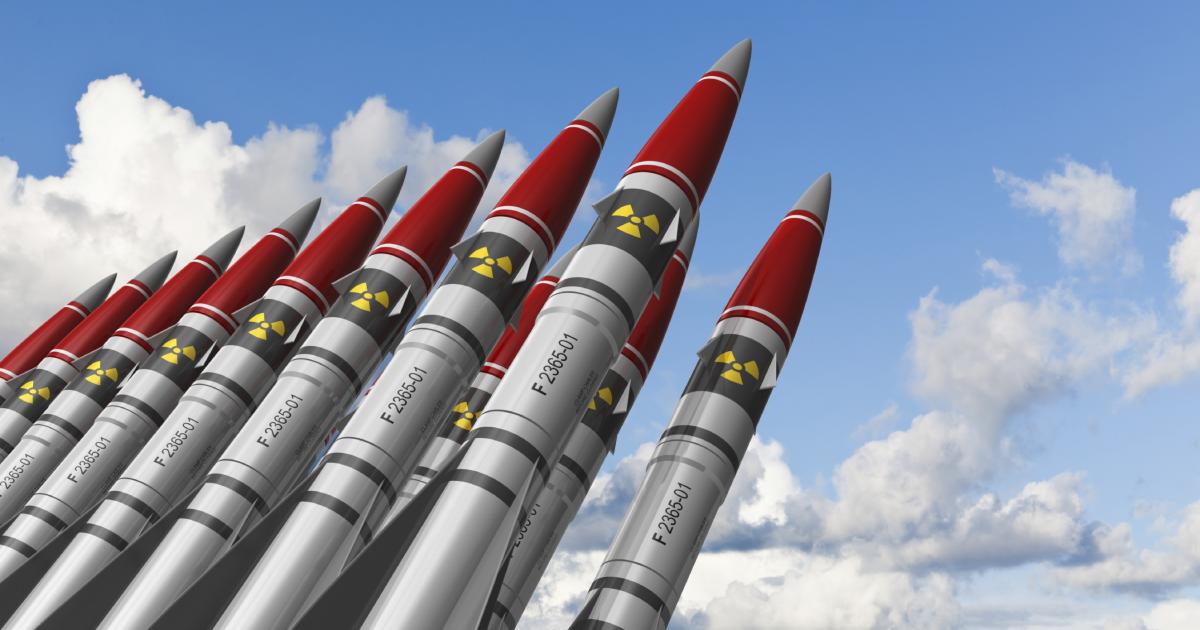- Energy & Environment
Adapted from prepared comments delivered by Sam Nunn on a Nov 5th, 2019 roundtable at the Hoover Institution.
I find it distasteful when people quote themselves, so let me quote three other people. And those people would be George Shultz, Bill Perry, and Henry Kissinger. These were the words they used 12 years ago, in the Wall Street Journal, “Unless urgent new actions are taken, the United States soon will be compelled to enter into a new nuclear era, that will be more precarious, psychologically disorientating, and economically more costly than was the Cold War deterrence.”1
I believe that we have entered into a new nuclear era: it’s an era of high risk and one of nuclear instability. Over the last two decades, a number of familiar events that have damaged relations between Russia and the West have led us to this point: friction over the Balkans, the war in Kosovo, the ongoing process of NATO enlargement, disputes over missile defense, and the Iraq War. And more recently: Russia’s invasion of Ukraine, the taking of Crimea, the invasion of Georgia, the war in Libya, Syria, election interference (which I view as a huge blunder by the Russians in terms of the effect of that on public sentiment in this country, and therefore the effect on them), and of course the resulting sanctions. If you are an American, you probably argue that the Russians are 90% at fault for them. And if you are Russian, then it is the United States at fault. But put all of those together, and the result is destabilization, no matter how you slice the blame.
Meanwhile, Russia’s evolving perception of its so-called “place in Europe” under President Putin—and particularly Putin—and as manifested in its invasion of Georgia and Ukraine have made Russia’s neighbors very fearful. I won’t claim in this era of instability that leaders in Washington or Moscow are planning a “bolt from the blue” nuclear attack. Rather, we have entered into an era where the risk of nuclear use has become disturbingly plausible once again—in particular in a crisis where judgement can be warped or made very hastily.
All that is needed is a spark to light the tinder. Barbara Tuchman, in her book The Guns of August, outlines how it was in fact by a series of blunders that European leaders led their nations into World War I—a war with 40 million casualties and one that also led to World War II two decades later. The battles of World War I were fought in trenches without nuclear weapons; today war between nuclear weapons states would exceed the levels of destruction of World Wars I and II combined, in less time than we will spend in this seminar today. Einstein supposedly said, “I know not what weapons will be used to fight World War III, but I’m confident that World War IV will be fought with sticks and stones.” That is the situation with nuclear weapons.
We have reached the point where misunderstandings, unintended signals, false warnings, or plain blunders may dominate. Not just between the United States and Russia, but also other weapons states—India and Pakistan, for example, which may be the most dangerous spot on the planet—or North Korea, or the Iranians. Today’s technologies also allow non-state actors to engage in mass destruction. There are many, many blessings of technology—but, technology has also helped democratize weapons of mass destruction. Add in cyber weapons—which have been regarded more as “weapons of mass disruption”—but which could also, perhaps unintentionally, lead to destruction.
The arms control situation is making this problem worse. The Anti-Ballistic Missile (ABM) Treaty, the Treaty on Conventional Armed Forces in Europe (CFE), the Intermediate-Range Nuclear Forces (INF) Treaty—they are all gone. Meanwhile, the Open Skies Treaty—which George Shultz, Bill Perry, and I wrote an op-ed about recently2—the Open Skies Treaty, the New START Treaty, and the Comprehensive Test Ban Treaty (CTBT) are hanging by slender threads. Even the Non-Proliferation Treaty (NPT), which has a five-year review cycle and is going to be reviewed in early 2020. There is always tension between the Nuclear Weapons States and the non-Nuclear Weapons States, but it has probably reached a new peak now in terms of global frustration with the Nuclear Weapons States.
While arms control is being dismantled or discontinued, the United States and Russia persist in Cold War, prompt-launch nuclear policies, alongside new threats in cyber that could compromise early warning and command-and-control systems and increase the risk of false-alarms. Emerging dual-use weapons systems that could be nuclear or conventional—hypersonic systems, for example—have the same problem. Technology is increasing nuclear risk, especially if we persist with the lack of red lines regarding its use. What is our policy, for example, in response to a cyber attack on a nuclear warning or command-and-control system? In the cyber world, we basically have the cowboys and the horses in the saloon, the cowboys are shooting up the place, and there is dynamite in the attic. That’s how I see cyber and nuclear coming together.
While risks of catastrophic blunder go up, decision time for leaders of nuclear weapons states is going down: this is the wrong direction. In fact, some serious thinkers are now so alarmed by compressed decision time (and recall that any warning could be a false one) that they are proposing and talking about automated nuclear response systems based upon artificial intelligence. In effect, a nuclear “dead hand,” coming close if not fully taking humans out of the decision loop in the last few minutes.
In our new nuclear moment, technology and science are outrunning governmental and international cooperation, outrunning human relations—and as the Rt Rev Bill Swing has said with so much moral authority—outrunning moral and ethical considerations. We’ve got to find ways to reverse this direction. We’ve got to find ways to use our technology to reduce risk and to give our citizens hope rather than fear. But today, as we sit here in the race between what I call cooperation and catastrophe, cooperation is in low gear. The United States and Russia and other nuclear powers should remember Winston Churchill’s admonition, “However beautiful the strategy, we occasionally have to look at the results.” And the results today are a world with much higher risk.
Ernie Moniz and I wrote a Foreign Affairs essay recently in which posited a scenario that led to the use of nuclear weapons.3 What was sobering is that we didn’t have to make any of it up. Those tinders are all in place. But even if you think that things would not unfold the way that particular scenario did, it should be disquieting to all of us to have that much explosive dry tinder lying on the ground. The bottom line is that the United States and Russia are now in a state of strategic instability, where accident or mishap could lead to war, including the potential use of nuclear weapons.
***
It’s worth looking for a moment on how we got here, and then I’ll have a few suggestions.
First, we have the nuclear legacy of the Cold War. Almost thirty years after the collapse of the Soviet Union, the United States and Russia both deploy about 2000 nuclear warheads on prompt-launch, ready to fire at the decision of two people: the President of the United States and the President of Russia. On the other side of the coin, the arms control architecture built up over many decades of the Cold War, as I have already mentioned, has broken down, and we are in danger of losing most, if not all, of the arms control agreements we now have over the next 2-3 years.
Second, our outdated Cold War postures exist alongside new threats in cyberspace and advances in military technology. One of the things I asked repeatedly while in the Senate was our own ability to terminate an accidentally launched ballistic missile. I never got what I considered to be a good answer to that question, especially if you consider that other satellite launches, military or civilian, can be terminated if they go off-course and threaten populated areas. There are targeting rules that are supposed to keep each side from aiming our weapons at each other until we really mean it, but there is no fail-safe against an accidental launch itself. As far as we know, Russian missiles are the same, as well as other nuclear weapons states. I’ve always found that somewhat baffling if you look at the stakes involved. Can you imagine the President of the United States having to call up the Russian President saying, “We’ve just had an accidental launch, it’s heading your way—we didn’t mean it.”
New Russian missile programs have caused a great deal of understandable concern on Capitol Hill. Jill Hruby, who formerly headed Sandia Labs, has recently produced a technical analysis of these for NTI4, along with an accompanying paper, which talks about the implications of those programs for nuclear diplomacy5.
Third, while technology has brought us great progress and many blessings, it has also democratized weapons of mass destruction and disruption more than ever before. If terrorists can get access to nuclear material, then they can figure out how to make a nuclear weapon. It’s not a piece of cake, but it’s doable. Or, if they can use cyber space, they can use it to confuse and disrupt, particularly command-and-control systems: I worry about Pakistan and India in that regard, even more than I worry about Russia and the United States. That is, someone intentionally using cyber to create the sense that one of the other countries is about to be attacked.
Fourth is that “incredibly shrinking decision time.” The combination of nuclear weapons still deployed on prompt launch, intersecting with advanced military technologies, further decreases warning and decision time for nuclear powers. And it increases the fear of military planners on both sides that a potential first strike could deliver a decisive advantage to the attacker. That’s what you don’t want: you don’t want any country to feel like they gain a decisive advantage by going first. That’s my simple definition of instability. Today, in a lot of situations, the Presidents of the United States or the President of Russia would only have a few precious minutes to make a decision which would basically determine the fate of mankind. That is not the kind of situation we want to persist for the next 20, 30, 40, 50 years.
The fifth point is that we don’t really talk anymore. During the Cold War, even at its peak, George Shultz was having serious conversations with Dobrynin and with other Soviet leaders that got to the heart of what both of us feared. But we are not doing that anymore in any serious way. This breakdown in communication has occurred over the last several years, and it has intensified with the Russian interference with the US election and Russia’s invasion of Ukraine and seizing of Crimea.
Pause for a moment and think about that. As we struggle to manage the legacy of the Cold War, and as arms control is collapsing, as military technologies are advancing, as decision time is decreasing—our response is to talk less, and even then only selectively. We even have legislation that has passed in the last several years that discourages military-to-military discussions, which are perhaps the most important of all, both in terms of crisis control (making sure we don’t have an accidental war), as well as overall questions of nuclear stability. It makes all the difference. They are professionals and they know what they are talking about. And given the right kind of mandates from civilian leaders, which is the way it has to occur, I think military-to-military could make a lot of progress in a lot of areas. But in Washington, DC today, there is almost no political space for discussions with the Russians or to even have serious discussion about the Russians.
The sixth point about where we are, and how we got here: whether it’s the United States or in Russia or elsewhere, we don’t have much memory in our leadership today. Personal memory of military or policy experience with nuclear weapons is basically gone. The effects of Hiroshima, Nagasaki, the Cuban Missile Crisis—those are fading. Bill Perry has often referenced this in his articles—the worst of all worlds is that we have all these nuclear weapons and we don’t really have people who take them seriously. That is certainly a danger. Complacency is disconnection from reality on the nuclear arena. George Shultz in his testimony before the Senate Armed Services Committee last year said, “I fear people have lost that sense of dread.” And that sense of dread is important in terms of leadership in the nuclear arena.
The seventh point is, as mentioned above, what David Hoffman called the “dead hand.” All of this is coming together in ways that dramatically increase the risk of nuclear use. You can take artificial intelligence as a tool to make decisions higher-quality and risk-reducing. But if artificial intelligence becomes the decision-maker itself, either in Russia or in the United States—certainly if in both—then I think that is an extremely destabilizing direction.
***
So what do we do about it?
I remember my colleague Senator Talmadge who was a close friend of Hubert Humphrey’s, but he loved to “run against Washington.” He said over and over again on the stump, it was a very funny line, “My friend Hubert Humphrey has got more solutions than the country’s got problems.” I don’t have as many solutions as I have pointed out problems, but let me name a few.
First is to create the political space for serious, strategic stability and risk reduction talks with Moscow, including civilian as well as military leaders. I would put this under an umbrella—particularly today where the US-Russian relations are so strained and there is no political space in Washington, DC—of existential common interests. There are some things we need to talk about no matter how many other differences we have. Right now, leadership in Congress is absolutely essential for this. It can’t come from the White House. The President does not have credibility on the Russian issue—not with the Democrats, who speak out about it, but also with the Republicans who talk about this quietly. Congress has really got to step up to the plate.
Ernie Moniz and I have proposed a new bipartisan liaison group to cover NATO, nuclear policy, and Russia—all three.6 They can’t be separated. We’ve talked on Capitol Hill, and we’ve talked to the leadership—Republicans and Democrats. They don’t say, “No.” They don’t say, “It’s crazy.” But the political atmosphere right now discourages leadership from taking a stand and moving in that direction. They would have to do it together, it would have to be bipartisan, and the group would have to include House and Senate leaders. And the group needs to be appointed by the leadership, because committee chairs don’t have the authority they once did.
Back when George Shultz was secretary of state, we had a congressional arms control observer group. Ted Stevens and I went to Robert Byrd and Bob Dole—those two leaders mandated the group and gave us the authority to coordinate with the executive branch. That’s where we started—we did an awful lot of coordination. I bet I was in Shultz’s office five or six times during that period. We were in Geneva. We worked with the state department. It was bipartisan. We had about 10 or 15 members, and the leaders, Byrd and Dole, actually went to Geneva with us at least twice. And that’s why the INF treaty was so successful in ratification. Substantively it made sense, but Congress was also in on the takeoff. So that’s our first recommendation, which we are working on. So far—a work in progress. Certainly can’t say a success at this stage.
The second recommendation is to broaden the agenda in our discussions with the Russians. We’ve got to allow them to put their fears on the table, and we’ve got to put our fears on the table. That doesn’t mean we are going to solve all the fears, but it means we’ve got to acknowledge them and talk about them and understand where each other are coming from. We are not going to ever solve all of their fears, because we know there is a certain degree of paranoia there, but nevertheless we’ve got to talk about them.
We should start with a crisis management dialogue, particularly US-Russia, but also NATO and Russia. In the immediate aftermath of the Georgia crisis a number of years ago, as well as the Ukraine crisis, we broke off all meaningful dialogue and forums that were designed specifically to manage crisis, like the NATO-Russian council. We seem to have the position now that diplomacy, even in a crisis, is a reward for good behavior: “If you don’t behave well then we are not going to talk to you.” To me though, it’s the opposite, particularly if you take an organization like the NATO-Russian Council, which was created for the purpose of easing some of the paranoia that was building in Russia because of the NATO expansion. And we are not utilizing it.
Third, we must begin strategic stability talks. The good news is that President Trump and President Putin agreed at one of their first summit conferences to have “strategic stability talks.” The bad news is that they haven’t done it. And even with the lack of credibility, and with all the strain, we need to initiate those talks. We should:
Enable military people, particularly on the nuclear side. When I’ve talked to our military commanders, particularly the recent ones, they want to know their counterparts. When I talk to our NATO commanders, they want to talk to their counterparts. And I think the Russians do too. But right now, that’s not happening, because they are not being allowed to talk.
Talk about a number of different weapon systems, including conventional and nuclear dual use, or about weapons that can be used for prompt launch.
Develop some red lines on cyber. We are not going to get a treaty on cyber anytime soon, but we’ve got to have an understanding—what each side will do if we start tinkering around in each other’s warning systems, or command and control systems? What do we do if Pakistan and India start doing this to each other? You could have an accidental war, with false alarms, very quickly.
Talk about the so-called tactical nuclear weapons based in Europe, including a base in Turkey. I call those, “Pre-positioned equipment for terrorism.” One of my first tours of NATO, back when I first got elected, was the tactical nuclear weapon bases. Back in the days of the German Baader-Meinhof gang—terrorists of a different kind than now—but nevertheless we had terrible security problems around those tactical bases. It takes tremendous amounts of manpower right there in the middle of Europe to properly secure those weapons. And God knows about the Russian security around their weapons. There is no military mission for those weapons now, and I haven’t talked to a single military leader who says there is a mission, but they are there politically to give comfort to allies. So we should address the political problem, and Russia needs to do the same thing. We both need to get them away from the heart of Europe.
Talk about missile defense, including the offense-defense relationship. NTI’s analysis of Russian missile programs shows that several of the new missiles have been developed primarily to go after our own missile defense systems. So we are beginning, what Paul Nitze warned of long ago, an offensive-defensive spiral. Nitze argued that we had to have defenses that are survivable, that are workable, and that are cost-effective at the margin— otherwise we going to go offense-defense, offense-defense, and evidence suggests that’s where we are now. Of course, we can’t solve all these problems in one negotiation. But we can sit down in something like a plenary session, talk about all these issues, acknowledge that these fears exist, and then break out various important parts of that with a chance of being agreed to. It doesn’t have to be a treaty—but it can be an agreement, or it can be a red line, or it can be a military-to-military understanding.
The fourth point is to find ways to increase decision time—whether nuclear or conventional, as with the now-gone CFE Treaty in Europe. I would make decision-time and confidence-building the organizing principal of future arms control. We’ve got to minimize fears of a short-warning attack, particularly a nuclear one, and we’ve got to find ways to give the Presidents of Russia and of the United States increased decision time. It’s going to take the best minds, and it’s worthy of the best minds we have, to find creative ways to do this. One way of doing it—carefully done by both countries, of course—would be to reduce the number of weapons on prompt launch from where they are now. You could also separate warheads from delivery systems, particularly fixed silo systems which invite first attack since they are so vulnerable. This was especially so in the past when they hosted MIRV missiles where you could take out ten weapons with one.
If I had my way, the most important arms control move that could be made would be President Putin and President Trump to get together and call in their military leaders and their scientific advisors and say, “Give us more decision time. If we’ve got 6 minutes now, give us 12. And when you get to 12, give us 20—and the 30, and then 40, and then an hour, and then a day, and then a week.” Soon you would make nuclear weapons less relevant. I do not believe we are going to succeed in reducing nuclear weapons in meaningful ways from this point on without making them less relevant in our force posture.
Fifth point, hang on to what works. New START could be renewed. We’ve got the Open Skies Treaty, which is working, certainly not perfectly, but it is working. Or the CTBT. These are constraints that give us predictability, give us transparency, and they avoid a complete breakdown of trust in what is otherwise a very difficult period. To the extent that there is difficulty in implementation of agreements, we should discuss them with Moscow—that’s what compliance commissions are for—instead of trashing treaties and agreements while the original risks remain. We still need a conventional forces understanding in Europe. And we still need to ban ground-based missiles, which is what the INF treaty was all about that. So we in arms control should find ways to update these treaties that need updating, rather than throwing them in the trash can.
Sixth, we have to take into account new technologies. No one can negotiate a treaty that can anticipate the next twenty years of technological development, so we’ve got to look at treaty negotiations in a different way. For example, we might have the possibility of treaties in some areas, but also agreements, or understandings, or military-to-military red lines that can’t be reduced to something in writing. It’s a different way to look at arms control. But it would be far preferable to no guard rails, and no understandings, and no red lines.
Seventh, new technologies can also be used to reduce risk. Over the years we done that, for example, in verification. Most arms control agreements would not have been possible without the kind of technology that would have given us the verification we needed. Our national labs and universities have to play a crucial role in this. So it’s got to be a national program. And I would challenge Russians to do the same things and then see where we can meet—find ways where their technologies or our technologies can work together.
I once had a bright fellow from RAND work for me a number of years ago. I asked, “What would you do?” He said, “One way you could deal with fixed silos on both sides is to put several thousand pound concrete blocks on top of the missile silos so that it would take several hours to remove, and you could monitor it on real time cameras, and also through national technical means.” It shows you an example of being a little bit creative. Now I’m sure that there are loopholes in that, but there are ways to do this. There are ways to make the world safer! But when you project where we are now, over the next 20 to 30 years, it seems to me it’s very dangerous.
Eighth, and last, a subject close to my heart. Congress and the senate. There is a lot concern in congress now about having a finger on the trigger, but it goes far beyond whomever happens to be president. There is a problem with one person making these decisions. Congress under the Constitution is supposed to make the decisions on war and peace, and yet the one type of war that could end the world as we know it, congress has virtually no role. But an irresponsible role is not going to work either. We should revisit the War Powers Act, which I voted for, but which has never worked. It’s not working now, and it’s never going to work the way it’s written. But the intent was to give Congress responsibility under the Constitution, which is clear.
So what can we do? Senator Byrd, Senator Warren, Senator Mitchell, Senator Pell, and several of us introduced a total revision of the War Powers Act in 1988. We worked on it for a year. It didn’t get implemented. But it was thought through nonetheless. Of course, it needs to be updated. But what we proposed then is worth looking at now: namely, to create a leadership group composed of chairman of committees, ranking members, and the leadership, that would meet with the executive branch on a regular basis on crucial national security issues. They would not be just in a crisis, but a regularized set of meetings. I don’t see how Congress as a whole, given the way it’s organized now, can have a way of making decisions on nuclear weapons. We’ve got to have a different kind of procedure. But the matter goes beyond nuclear use, and it goes to the question of how Congress can play its constitutional role. This kind of leadership council would meet on a regular basis with the secretary of state, and with the secretary of defense, and understand what is going on in various parts of the world, because crises can come up very quickly.
Warren Buffet, who is pretty good with numbers and with probabilities, tells me that if an event has a 10% chance in a given year, and that chance persists for 50 years, then there is a 99.5% chance that it will happen over that 50 year period. But if you can reduce that 10% chance to a 1% chance, and that chance again persists for 50 years, then you have a 67.5% chance of it not happening. So, while we are looking for the ultimate goal of getting rid of nuclear weapons, in the meantime we’ve got to reduce risk. “We” being plural. It’s not just the United States—it’s Russia and it’s all the weapons states.
I really do believe that we need a national effort with our best brains to look at this whole question of nuclear risk.
Sam Nunn is the co-chair of the Nuclear Threat Initiative and an Annenberg Distinguished Fellow at the Hoover Institution. He served as a U.S. senator from Georgia from 1972 to 1996 and is a distinguished professor at the Sam Nunn School of International Affairs at the Georgia Institute of Technology.







